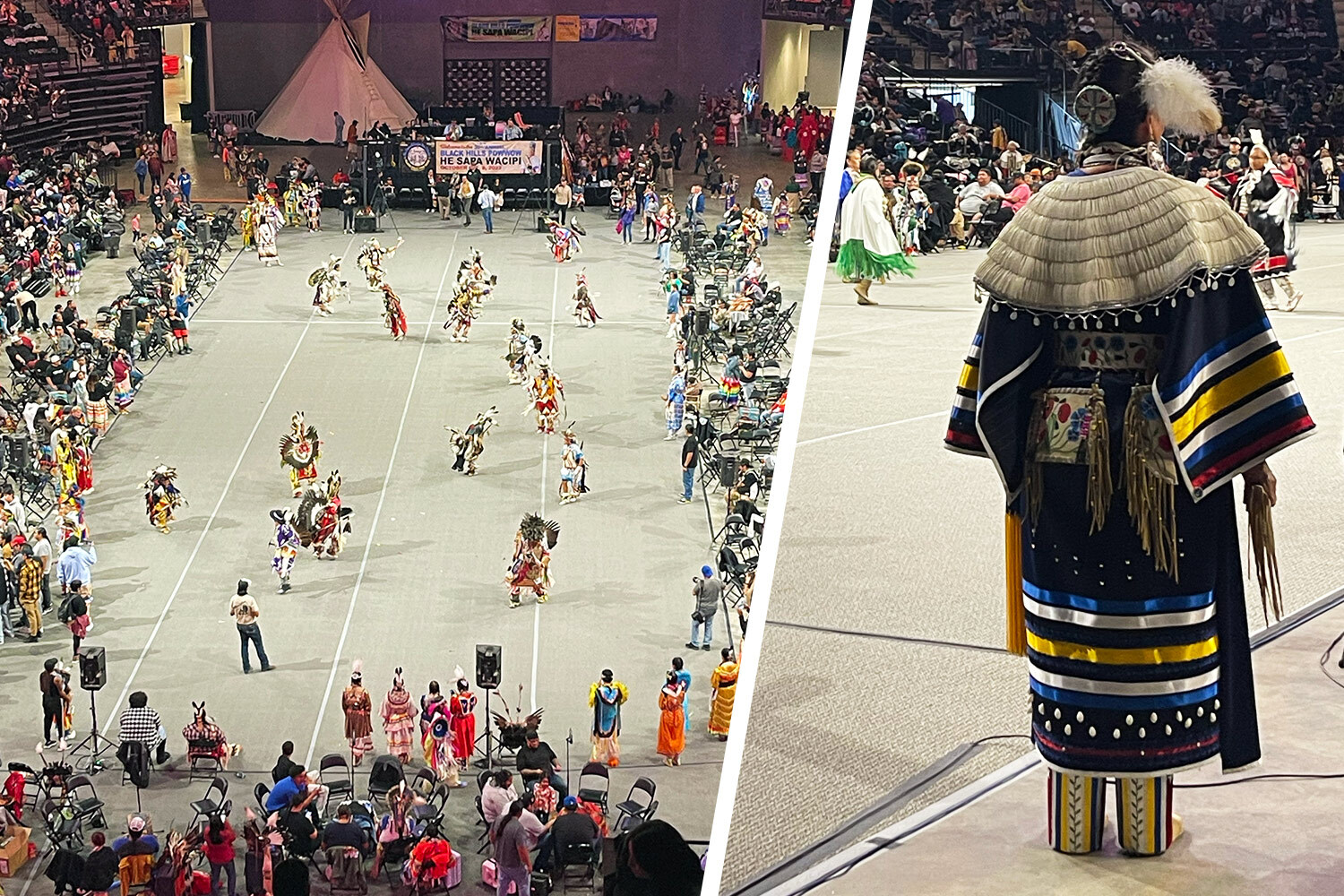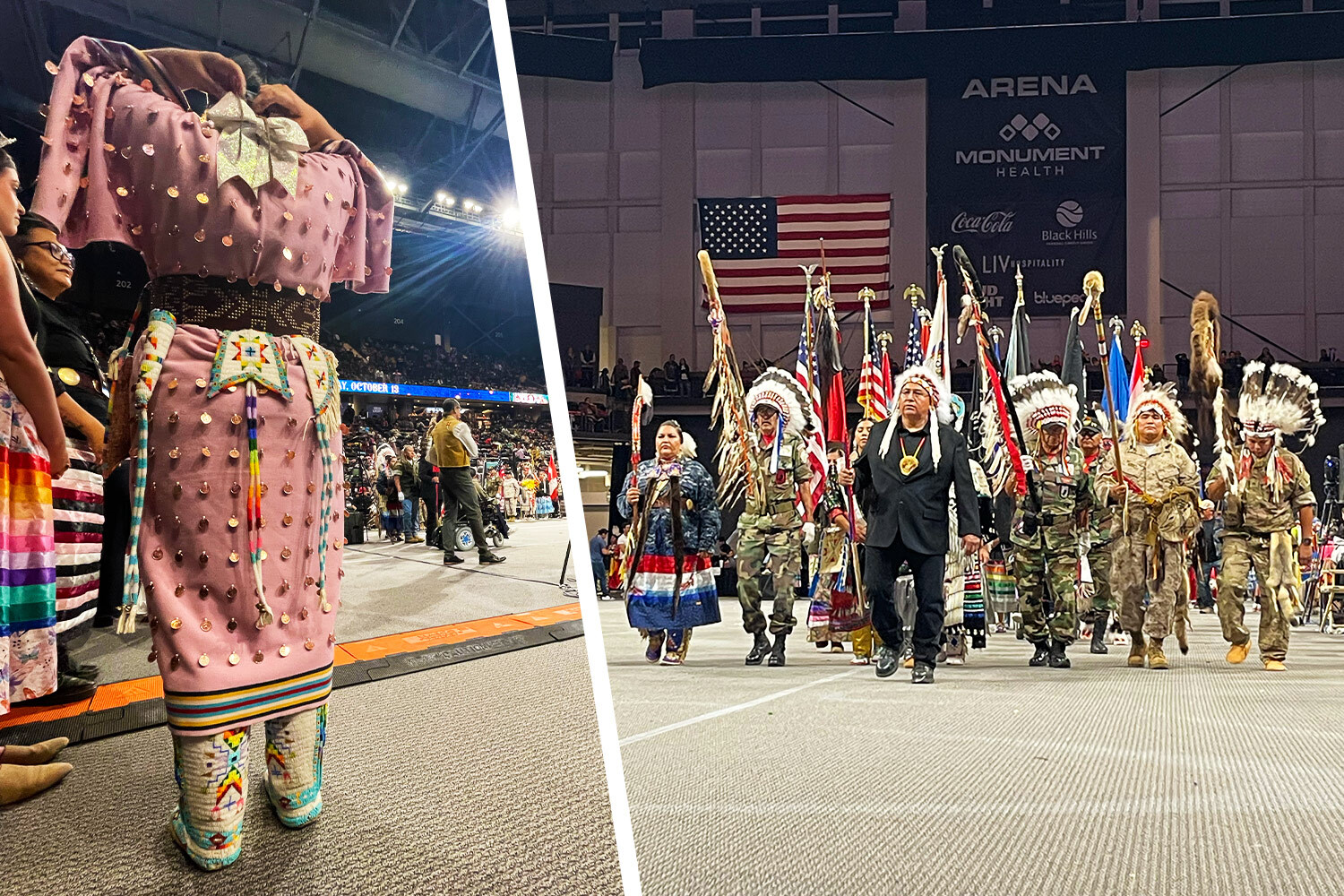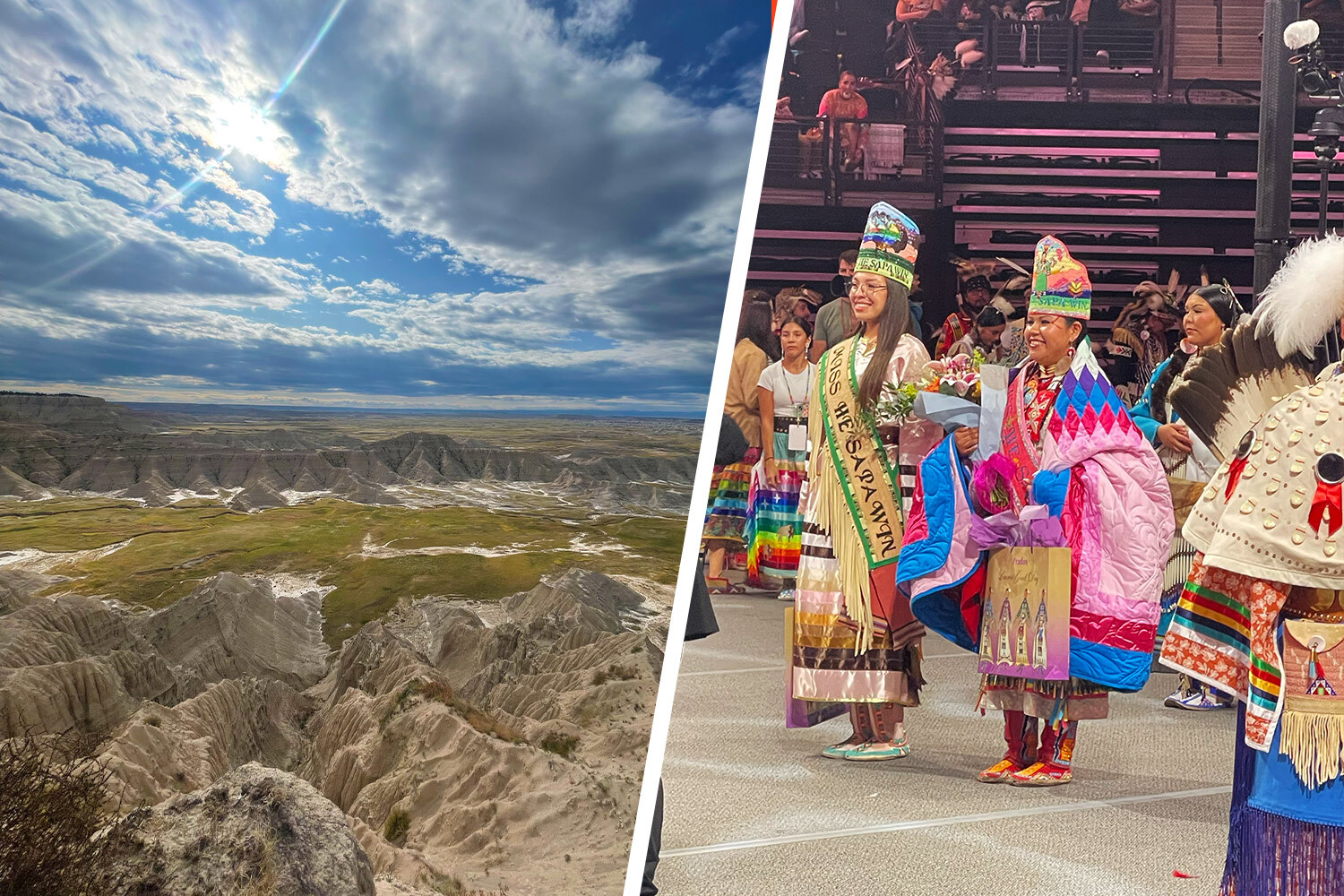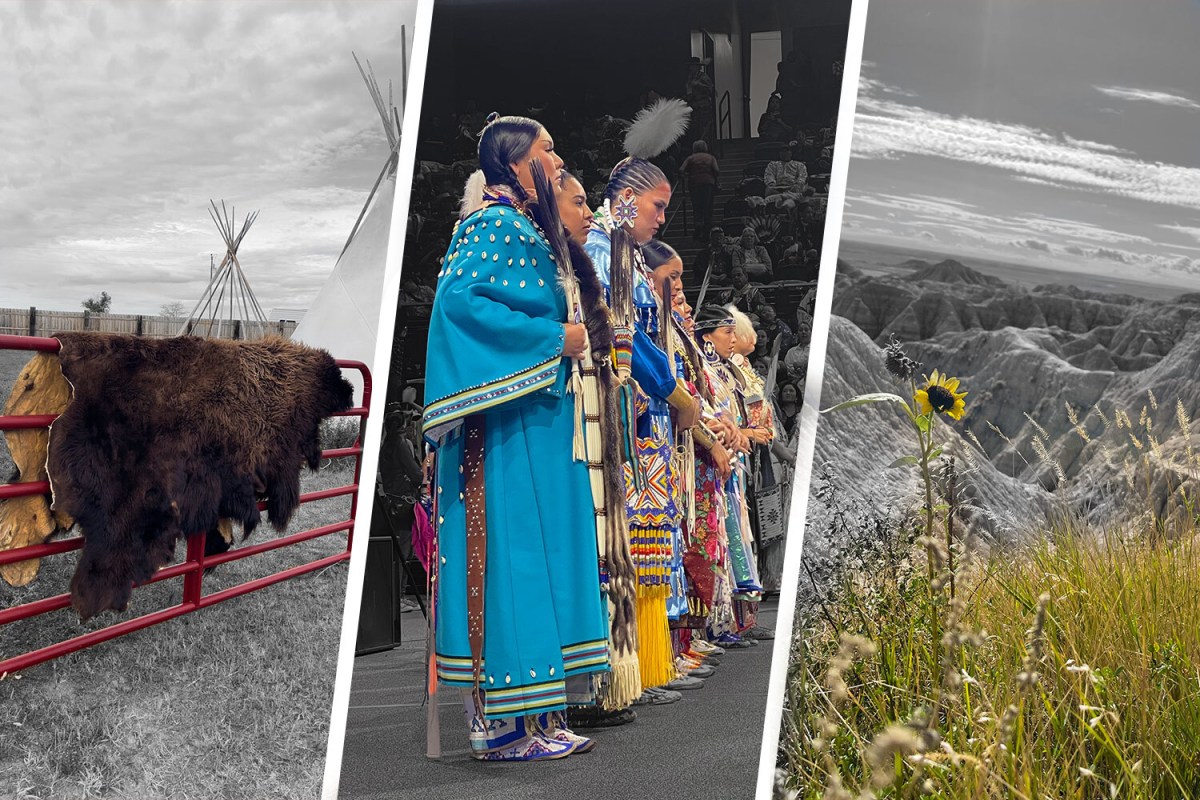At the Black Hills Pow Wow in Rapid City, South Dakota, I’m sitting on the floor of The Monument exhibition center, taking photos of the Veteran’s Grand Entry, where Native American veterans and dignitaries make their way across the arena floor, wearing their military dress plus tribal regalia like headdresses and face paint. It’s a special moment where all in attendance honor these Indigenous veterans, and family and friends make their way through the crowds to get videos and pictures of their loved ones who are part of the Grand Entry. I’m in a good place sitting on the floor just outside the arena, having already checked with those around me that I’m not in the way, while also allowing family and friends of Grand Entry participants to pass in front of me when they need. Suddenly, a fellow attendee, who doesn’t have family or friends in the Grand Entry, bulldozes past me and others and stands directly in front of everyone to take his own pictures, with no regard to those around him.
“Hey! Can you watch out for those of us trying to take pictures behind you?” says a Native American attendee near me. “My relatives are out there, and these pictures are more important for me than you.” I’m embarrassed, yet not even involved in the scene. It makes me realize how uneducated people can be when it comes to visiting Native American events and traveling on Indigenous lands. And it makes me sad.
Native Americans inhabited North America long before the European colonization of the U.S. and Canada. For thousands of years, this was their home before they were forced off their tribal lands and sent to live on reservations. Throughout time, Native Americans have been stripped of their homelands through broken treaties and forceful relocation. Their cultures and traditions were ripped away, and they were made to learn English, cut their hair and take on common, English names instead of their Native ones. It is undoubtedly one of the greatest losses of the U.S., culturally and demographically, and a stain on American history.
Today, however, efforts across North America are being made to keep Indigenous traditions and history alive, whether it’s through pow wows, museums and cultural centers, national and state parks, and in Native communities. When visiting Indigenous places, whether they’re public or you’re allowed private access to communities, it’s important to educate yourself on the area’s Native American history, traditions and modern way of life. In honor of Native American Heritage Month, we’ve curated a guide for being a respectful and responsible traveler when on Indigenous lands.

Reach Out Before Visiting
If you plan to travel to reservations and Native communities, it’s best to contact each tribe or Native Nation beforehand if you’d like to speak with someone about local culture or visit on-site visitor centers. Each Native community is different, and what might be okay in one place might not be in another.
“This is a great idea to see if they’re welcoming visitors or hosting sacred events on a particular day and not open to the public,” says Sherry L. Rupert, CEO of the American Indian Alaska Native Tourism Association (AIANTA). You should also research the communities you plan to visit and then be prepared to ask questions on site.
“Visitors should remember they’re able to tour tribal land only because they’ve been granted permission by tribal landowners,” Rupert adds. “What those landowners allow is subject to change between different tribal groups, but most are happy to share information about their culture if asked respectfully.”
Lots of tribes have contact information on their websites, or you can reach out to local tourism boards and tribal administration offices for help as well. South Dakota, for example, has a Guide to Tribal Nations, the New Mexico Tourism Department also has visitor information on their Native American communities, and Visit Utah has information on the state’s tribes and how to visit.

Learn About Native Culture
Before your trip, educate yourself on the area’s Indigenous history. This way, you’ll be able to ask better questions when visiting communities and public spaces. It’s also important to educate yourself during your travels, and you can do so by visiting Native American museums, cultural centers and even some visitor centers at state and national parks.
The Black Hills Pow Wow offers a Wacipi (“pow wow” in Lakota) 101 class, which is free with admission for all attendees. Dew Bad Warrior-Ganje, the vice president of the Black Hills Pow Wow, says the Wacipi 101 class is exclusive to the Black Hills Pow Wow, and a great way for visitors to learn more while attending.
“We’ve found that it helps people to better understand, interact and have a deeper appreciation for our culture,” she says. “You’re able to understand pow wows better and ask questions in a safe space.” Wacipi 101 includes information on different pow wow dances, how a pow wow works and discussion of regalia, as many include eagle feathers and it’s disrespectful to touch these outfits or bump into feathers. “When you understand what’s happening in the arena around you, you gain more appreciation for it,” says Bad Warrior-Ganje.
You can also educate yourself while on tours of Native lands and parks. On a day-long tour of Badlands National Park with Black Hills Adventure Tours, my guide, Denny Gienger, talked over the entire history of the Black Hills area, which included discussions about the Lakota, Dakota and Nakota people, their traditions and their forced migration from their lands to reservations. Black Hills Adventure Tours also works with Tatanka Rez Tourz, a Native American-owned tour company, when guiding visitors through the Pine Ridge Reservation.
Where to Eat, Stay and Travel for Authentic Indigenous Experiences
From Minneapolis to Santa Fe, Native American chefs, producers and artists are finally getting their dueBe Cautious When Photographing
It’s important to ask before taking photos or recording when visiting a reservation, Indigenous event, or on Native lands. “Unless you see a sign posted on the premises, always ask before photographing or recording an individual, event or activity, as there are some reservations that don’t allow photography or require a paid permit,” Rupert notes. Gienger adds to this, saying that some communities may have policies about photographs or sketching, and that visitors should always ask for permission first. During my Wacipi 101 class, I learned that there are times at pow wows where certain dances, prayers and events cannot be recorded or photographed, so it’s important to listen for announcements on when to put your camera and phone away.

Be Respectful
When traveling on reservations or in public spaces, it’s important to be respectful of Native policies and practice common courtesy just like you would in any other private space and sacred place. In public parks, stay on marked trails if there are any, and make sure not to litter. Better yet, be a good citizen and pick up any pieces of trash you might see to leave the space better than you found it.
It’s also important to stay back from wildlife. Rupert adds that visitors should be aware of surroundings and pay attention to signage, obey individual tribal rules and regulations and be respectful of local culture. “Although local customs vary, dressing modestly, listening when elders are speaking, and leaving artifacts where they lie helps ensure that you are not disrespecting the local norms,” she says. Gienger notes that travelers should also observe holy ceremonies or spiritual customs or sites: “It’s important not to disturb these sites or offerings like prayer bundles, or other items which may have been offered in remembrance of ancestors.”
Louis Williams, owner of Ancient Wayves, a Navajo-owned outfitter doing hiking, backpacking and rafting trips in Bears Ears National Monument and on the San Juan River in Utah, adds to the argument. “In my culture, we often personify rock formations, water sources and plant life,” he explains. “These landscapes, waterscapes and organisms have a life story as well just like humans. If we’re able to keep the places we visit intact and undisturbed, future generations will have the opportunity to see and visit these awesome places, too.”
Support Indigenous Businesses
If you can take a tour from a Native-owned company, buy jewelry and other wares from Indigenous makers, or spend money in an Indigenous gift shop or cultural center, this is a great way to support Native Americans and to put money back into the local economy. Ancient Wayves incorporates Indigenous history into their guided tours.
“Our guides have Indigenous roots connected to the region, and their family stories are part of the local history,” Williams says. “A majority of tourists who come to the region are fascinated by the extensive Indigenous history that exists in Utah, and our guides love to share with guests the local culture and unique stories about this historical landscape.”
Rupert echoes this statement and says that there’s no one who can share these stories and experiences like the land’s original inhabitants, and when buying authentic art, you should request a written guarantee or verification of authenticity and get a receipt that includes vital information about your purchase including price, maker and maker’s tribal affiliation. Under the Indian Arts and Crafts Act, all American Indian and Alaska Native art and craft products must be marketed truthfully regarding the Native American heritage and tribal affiliation of the artist or craftsperson.
This article appeared in an InsideHook newsletter. Sign up for free to get more on travel, wellness, style, drinking, and culture.

























